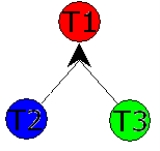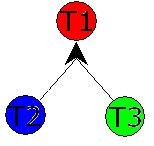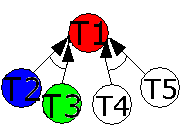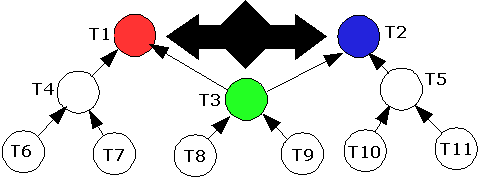
Conversation Theory
Encyclopedia
Conversation Theory is a cybernetic and dialectic
framework that offers a scientific theory to explain how interactions lead to "construction of knowledge", or, "knowing": wishing to preserve both the dynamic/kinetic quality, and the necessity for there to be a "knower". This work is proposed by Gordon Pask
in the 1970s.
s. But since meanings are agreed, and the agreements can be illusory and transient, scientific research requires stable reference points in human
transactions to allow for reproducible results. Pask found these points to be the understandings which arise in the conversations between two participating individuals, and which he defined rigorously.
Conversation Theory describes interaction between two or more cognitive systems, such as a teacher
and a student
or distinct perspectives within one individual, and how they engage in a dialog over a given concept and identify differences in how they understand it.
Conversation Theory came out of the work of Gordon Pask
on instructional design and models of individual learning styles. In regard to learning styles, he identified conditions required for concept sharing and described the learning styles
holist, serialist, and their optimal mixture versatile. He proposed a rigorous model of analogy relations.
The relation of one topic to another by an analogy can also be seen as a restriction on a mapping and a distinction to produce the second topic or concept.
Lp was Pask's protolanguage which produced operators like Ap which concurrently executes, Con, the concept of a Topic, T to produce a Description, D. Thus:
Ap(Con(T)) => D(T), where => stands for produces.
A succinct account of these operators is presented in Pask Amongst many fascinating insights he points out three indexes are required for concurrent execution, two for parallel and one to designate a serial process. He subsumes this complexity by designating participants A, B etc.
In Commentary toward the end of Pask he states:
Pask identified two different types of learning strategies:
The ideal is the versatile learner who is neither vacuous holist "globe trotter" nor serialist who knows little of the context of his work.
Dialectic
Dialectic is a method of argument for resolving disagreement that has been central to Indic and European philosophy since antiquity. The word dialectic originated in Ancient Greece, and was made popular by Plato in the Socratic dialogues...
framework that offers a scientific theory to explain how interactions lead to "construction of knowledge", or, "knowing": wishing to preserve both the dynamic/kinetic quality, and the necessity for there to be a "knower". This work is proposed by Gordon Pask
Gordon Pask
Andrew Gordon Speedie Pask was an English cybernetician and psychologist who made significant contributions to cybernetics, instructional psychology, experimental epistemology and educational technology....
in the 1970s.
Overview
Conversation Theory regards social systems as symbolic, language-oriented systems where responses depend on one person's interpretation of another person's behavior, and where meanings are agreed through conversationConversation
Conversation is a form of interactive, spontaneous communication between two or more people who are following rules of etiquette.Conversation analysis is a branch of sociology which studies the structure and organization of human interaction, with a more specific focus on conversational...
s. But since meanings are agreed, and the agreements can be illusory and transient, scientific research requires stable reference points in human
Human
Humans are the only living species in the Homo genus...
transactions to allow for reproducible results. Pask found these points to be the understandings which arise in the conversations between two participating individuals, and which he defined rigorously.
Conversation Theory describes interaction between two or more cognitive systems, such as a teacher
Teacher
A teacher or schoolteacher is a person who provides education for pupils and students . The role of teacher is often formal and ongoing, carried out at a school or other place of formal education. In many countries, a person who wishes to become a teacher must first obtain specified professional...
and a student
Student
A student is a learner, or someone who attends an educational institution. In some nations, the English term is reserved for those who attend university, while a schoolchild under the age of eighteen is called a pupil in English...
or distinct perspectives within one individual, and how they engage in a dialog over a given concept and identify differences in how they understand it.
Conversation Theory came out of the work of Gordon Pask
Gordon Pask
Andrew Gordon Speedie Pask was an English cybernetician and psychologist who made significant contributions to cybernetics, instructional psychology, experimental epistemology and educational technology....
on instructional design and models of individual learning styles. In regard to learning styles, he identified conditions required for concept sharing and described the learning styles
Learning styles
Learning styles are various approaches or ways of learning. They involve educating methods, particular to an individual, that are presumed to allow that individual to learn best. Most people prefer an identifiable method of interacting with, taking in, and processing stimuli or information...
holist, serialist, and their optimal mixture versatile. He proposed a rigorous model of analogy relations.
Topics
Conversation Theory as developed by Pask originated from this cybernetics framework and attempts to explain learning in both living organisms and machines. The fundamental idea of the theory was that learning occurs through conversations about a subject matter which serves to make knowledge explicit.Levels of conversation
Conversations can be conducted at a number of different levels:- Natural language (general discussion)
- Object languages (for discussing the subject matter)
- Metalanguages (for talking about learning/language)
Conversation
Through recursive interactions called "Conversation" their differences may be reduced until agreement—that is, agreement up to a point which Pask called "agreement over an understanding"--may be reached. A residue of the interaction may be captured as an "entailment mesh", an organized and publicly available collection of resultant knowledge, itself a major product of the theory as devotees argue they afford many advantages over semantic networks and other, less formalized and non-experimentally based "representations of knowledge". |  |  |
| Lastly a formal analogy is shown where the derivations of the concept triples are indicated. The diamond shape denotes analogy and can exist between any three topics because of the shared meanings and differences. |
 |
The relation of one topic to another by an analogy can also be seen as a restriction on a mapping and a distinction to produce the second topic or concept.
Cognitive Reflector
From Conversation Theory Pask developed what he called a "Cognitive Reflector". This is a virtual machine for selecting and executing concepts or topics from an entailment mesh shared by at least a pair of participants. It features an external modelling facility on which agreement between, say, a teacher and pupil may be shown by reproducing public descriptions of behaviour. We see this in essay and report writing or the "practicals" of science teaching.Lp was Pask's protolanguage which produced operators like Ap which concurrently executes, Con, the concept of a Topic, T to produce a Description, D. Thus:
Ap(Con(T)) => D(T), where => stands for produces.
A succinct account of these operators is presented in Pask Amongst many fascinating insights he points out three indexes are required for concurrent execution, two for parallel and one to designate a serial process. He subsumes this complexity by designating participants A, B etc.
In Commentary toward the end of Pask he states:
- The form not the content of the theories (conversation theory and interactions of actors theory) return to and is congruent with the forms of physical theories; such as wave particle duality (the set theoretic unfoldment part of conversation theory is a radiation and its reception is the interpretation by the recipient of the descriptions so exchanged, and vice versa). The particle aspect is the recompilation by the listener of what a speaker is saying. Theories of many universes, one at least for each participant A and one to participant B- are bridged by analogy. As before this is the truth value of any interaction; the metaphor for which is culture itself.
Learning strategies
In order to facilitate learning, Pask argued that subject matter should be represented in the form of structures which show what is to be learned. These structures exist in a variety of different levels depending upon the extent of the relationships displayed. The critical method of learning according to Conversation Theory is "teachback" in which one person teaches another what they have learned.Pask identified two different types of learning strategies:
- Serialists – Progress through a structure in a sequential fashion
- Holists - Look for higher order relations
The ideal is the versatile learner who is neither vacuous holist "globe trotter" nor serialist who knows little of the context of his work.
Further reading
- Ranulph Glanville and Karl H. Muller (eds.), Gordon Pask, Philosopher Mechanic- An Introduction to the Cybernetician's Cybernetician edition echoraum 2007 ISBN 9783901941153
- Aleksej Heinze, Chris Procter, "Use of conversation theory to underpin blended learning", in: International Journal of Teaching and Case Studies (2007) - Vol. 1, No.1/2 pp. 108 – 120
- W. R. Klemm, Software Issues for Applying Conversation Theory For Effective Collaboration Via the Internet, Manuscript 2002.
- Gordon Pask, Conversation, cognition and learning. New York: Elsevier, 1975.
- Gordon Pask, The Cybernetics of Human Learning and Performance, Hutchinson. 1975
- Gordon Pask, Conversation Theory, Applications in Education and Epistemology, Elsevier, 1976.
- Gordon Pask, Heinz von Foerster's Self-Organisation, the Progenitor of Conversation and Interaction Theories, 1996.
External links
- PDFs of Pask's books and key papers at pangaro.com
- Conversation Theory - Gordon Pask overview from web.cortland.edu.
- Cybernetics And Conversation by Paul Pangaro, 1994-2000.
- Conversation Theory: Reasoning about significance and mutuality by Mike Martin and John Dobson,
- Conversation Theory developed by the cybernetician Gordon Pask by Yitzhak I. Hayut-Man ea, 1995.

